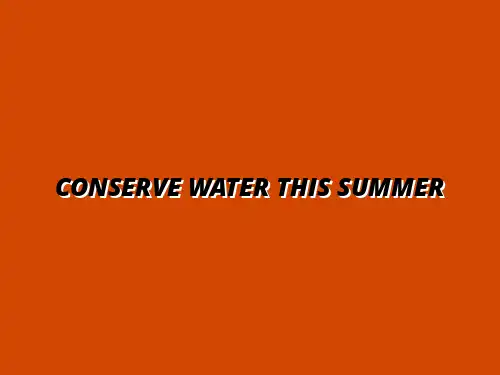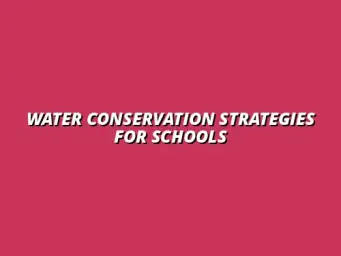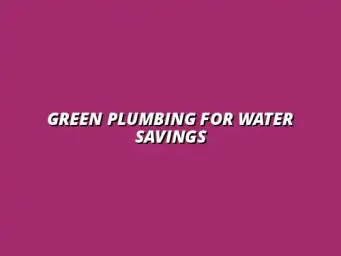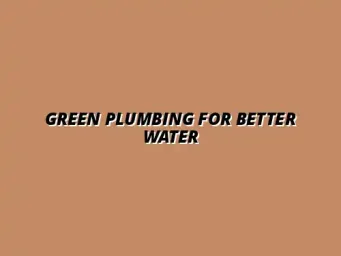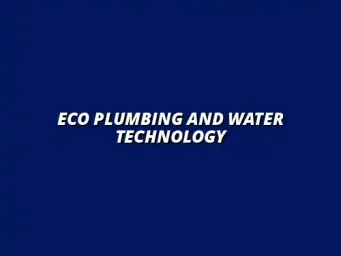Understanding the Importance of Water Conservation in Summer
Water conservation becomes particularly crucial during the summer months. As temperatures rise and outdoor activities increase, the demand for water often spikes dramatically. This puts a strain on our water resources, making it essential for everyone to take steps to use water wisely.
Understanding why summer is such a challenging time for water availability can help motivate us to change our habits. In many regions, summer months bring droughts or reduced rainfall, which can lead to water shortages. By learning about our consumption patterns, we can better manage our water usage and contribute to conservation efforts. For more practical tips on reducing daily water waste, check out these simple water-saving habits.
The Impact of Summer on Water Resources
During the summer, the impact of rising temperatures can be felt across various aspects of our daily lives. Not only does it increase water demand for drinking and bathing, but also for outdoor activities like watering lawns and gardens. Efficient irrigation is key to saving water outdoors; learn more about efficient irrigation for water savings. Overall, the need for water during this season can grow significantly.
Moreover, seasonal changes affect the availability of water. Many areas experience reduced water flow in rivers and streams during the hot months, which can lead to restrictions on outdoor water use. Understanding these patterns can help us prepare better and make necessary adjustments in our water consumption.
- Higher temperatures lead to increased evaporation.
- Outdoor activities require more water for upkeep.
- Reduced rainfall limits natural water replenishment.
How Increased Temperatures Affect Water Demand
As the temperature rises in summer, our demand for water typically increases as well. We tend to drink more water to stay hydrated, and we may also need to shower more frequently to cool off. This surge in consumption can quickly add up, impacting our overall water use.
Additionally, many people water their gardens and lawns more often to keep them alive during the heat. This practice can lead to excessive water usage if not managed wisely. Recognizing how temperature influences our habits is the first step toward more sustainable practices. Implementing water-saving tips for your home can make a big difference.
The Role of Seasonal Changes in Water Availability
Seasonal changes can greatly impact the availability of water resources in our environment. As summer arrives, many regions may experience lower water levels in lakes and reservoirs. These changes can directly affect how much water we have access to for everyday use.
With water scarcity becoming a pressing issue, understanding seasonal patterns can guide us in making smarter choices. By modifying our water usage based on the time of year, we can play a vital role in conserving this precious resource.
Strategies for Reducing Water Consumption During the Summer
Finding effective strategies for reducing water consumption during the summer can significantly ease the pressure on local water supplies. Many methods require minimal effort but can lead to substantial savings. By implementing these techniques, we can all contribute to a sustainable future.
From simple habits at home to outdoor practices, there are numerous ways to conserve water. Every drop saved can make a difference, especially during the hot summer months. Here are some strategies that can help you reduce your water consumption. For example, you can find many useful tips on conserving water in the bathroom.
- Fix leaks promptly to avoid water waste.
- Limit shower time to conserve water.
- Use a broom instead of a hose to clean driveways.
Effective Practices for Indoor Water Conservation
Indoor water conservation is a critical aspect of reducing overall water use. By focusing on areas where we consume the most water, we can make meaningful changes. Simple adjustments in our daily routines can help us save water without sacrificing comfort.
Every part of our home can contribute to water savings. From the kitchen to the bathroom, there are effective practices we can adopt. Here are some ideas to get started: Regular checks on your water pressure are also important. Learn more about regular water pressure checks.
- Turn off the tap while brushing teeth.
- Use a dishwasher instead of handwashing dishes.
- Install low-flow showerheads and faucets.
Optimizing Water Use in Kitchens and Bathrooms
Optimizing water use in kitchens and bathrooms can lead to significant water savings. These areas are where we usually consume the most water at home. By making small changes, we can achieve efficient water usage without much effort.
In the kitchen, using the dishwasher can save more water than washing dishes by hand, especially when it’s full. In bathrooms, shorter showers and water-efficient fixtures can dramatically reduce water use. Improving your water heater efficiency can also save water and money. Check out these DIY tips for water heater efficiency. Here are some tips for optimizing water use:
- Only run the dishwasher or washing machine with full loads.
- Take shorter showers or use a timer.
- Consider installing dual-flush toilets for efficiency.
Implementing Efficient Dishwashing and Laundry Techniques
When it comes to dishwashing and laundry, efficiency can make all the difference. Knowing how to maximize water use in these daily tasks helps reduce overall consumption. Simple techniques can lead to substantial savings over time.
For dishwashing, scraping plates instead of rinsing them can help save water. Similarly, choosing the right load size for your washing machine ensures water isn’t wasted. Adopting simple water-saving habits can significantly impact your water bill. Here are a few practices to consider:
- Fill the sink with water instead of running the tap.
- Use energy-efficient appliances that save water.
- Wash clothes in cold water when possible.
Outdoor Water Conservation Techniques
Outdoor water conservation is equally important, especially during the hot summer months. Utilizing techniques that minimize water use outdoors can have a significant impact on overall water consumption. From gardening practices to irrigation methods, there are many ways to save water outside.
By being mindful of how we use water outdoors, we can maintain our gardens while conserving resources. Here are some effective outdoor water conservation techniques to consider:
- Water lawns early in the morning or late in the evening.
- Use mulch to retain moisture in gardens.
- Collect rainwater for watering plants.
Creating a Drought-Resistant Garden
Creating a drought-resistant garden can help minimize water use while still enjoying a beautiful outdoor space. Selecting the right plants is crucial; native and drought-tolerant plants require less water to thrive. This not only conserves water but also supports local ecosystems.
Additionally, implementing strategies such as xeriscaping can transform your garden into a low-water landscape. With the right planning, you can enjoy a vibrant garden while significantly reducing water consumption:
- Choose plants that require little water.
- Group plants with similar water needs together.
- Incorporate stones or gravel to reduce evaporation.
Utilizing Rain Barrels and Smart Irrigation Systems
Utilizing rain barrels and smart irrigation systems can greatly enhance outdoor water conservation. Collecting rainwater in barrels allows you to use natural water for your plants and garden. This simple practice can help reduce reliance on municipal water sources.
Smart irrigation systems take this a step further by automatically adjusting watering based on weather conditions. These systems ensure that plants receive the right amount of water without waste. Here are key benefits of these practices:
- Rain barrels reduce stormwater runoff.
- Smart irrigation saves time and resources.
- Both practices lower your water bill.
Innovative Technologies for Water Savings
Innovative technologies are transforming how we approach water conservation. From water-saving appliances to smart home solutions, these advancements can help us monitor and reduce water use effectively. Embracing technology can simplify the task of conserving water.
Using these innovations not only helps in saving water but also promotes efficient usage. By integrating smart systems into our homes, we can track our consumption and make informed decisions. Here are some innovative technologies that can help:
- Low-flow showerheads and faucets.
- Smart irrigation controllers.
- Water leak detection devices.
Water-Saving Appliances and Fixtures
Water-saving appliances and fixtures are designed to use less water without compromising performance. These innovations play a crucial role in indoor water conservation efforts. By upgrading to these appliances, you can significantly reduce your water usage.
For example, modern dishwashers and washing machines are built to be more efficient. They use sensor technology to determine the appropriate water level needed for each load. Consider these products when looking to conserve water:
- High-efficiency washing machines.
- Low-flow toilets that save gallons per flush.
- Eco-friendly showerheads that reduce flow without sacrificing pressure.
Smart Home Solutions for Monitoring Water Usage
Smart home solutions can take water conservation to the next level. These technologies allow homeowners to monitor and manage their water usage in real-time. With the help of apps and devices, tracking consumption becomes easier than ever!
Utilizing smart meters and sensors, you can receive alerts about unusual water usage patterns. This helps in identifying leaks and making adjustments promptly. Here are some smart home solutions worth considering:
- Smart water meters that provide real-time data.
- Leak detection systems that alert homeowners.
- Mobile apps for tracking water usage trends.
Addressing Common Questions About Water Consumption
As we become more aware of our water consumption, it’s natural to have questions about how much water is used and the best practices for conservation. Addressing these common queries helps shed light on the importance of responsible water use during the summer months. By understanding our habits, we can make informed decisions.
Many people wonder how changes in their daily routines can impact overall water usage. By exploring these questions, we can find ways to conserve water effectively. Let’s dive into some frequently asked questions:
- What are the average water use figures per household?
- When is the best time for outdoor watering?
- How can technology support water-saving efforts?
How Much Water Does an Average Household Use in Summer?
On average, a typical household uses a significant amount of water during the summer months. This includes water for drinking, bathing, cooking, and taking care of outdoor spaces. Being aware of these figures can help us realize the need for conservation.
Statistics show that households can use up to 300 gallons of water a day in summer, with outdoor use often accounting for a large portion of that total. Understanding where this water goes can help us identify areas for improvement.
What Are the Best Times for Outdoor Watering?
Knowing when to water your garden can make a big difference in water conservation efforts. Watering during the hottest parts of the day can lead to high evaporation rates, wasting precious water. Instead, choosing the optimal times can not only save water but also keep your plants healthy.
The best times for outdoor watering are typically early in the morning or late in the evening. This ensures that more water reaches the roots of your plants rather than evaporating into the air. Here’s a quick guide:
- Water early morning between 5 AM and 8 AM.
- Water late evening after 6 PM.
- Avoid watering during the hottest parts of the day.
Understanding Watering Schedules to Minimize Evaporation
Establishing a watering schedule is a smart way to minimize evaporation and enhance water efficiency. By planning when and how much to water, you can help ensure your plants receive the moisture they need without waste. This is especially important during the hot summer months when water is at a premium.
Incorporating techniques like deep watering and focusing on plant needs can also promote healthy growth while conserving water. Here are some tips for creating an effective watering schedule:
- Water deeply but less frequently.
- Observe weather conditions and adjust accordingly.
- Use timers to ensure consistent watering times.
Can Technology Help in Reducing Water Waste?
Technology plays a vital role in reducing water waste and promoting conservation. From smart devices to efficient appliances, innovations are changing the way we manage our water usage. By embracing these technologies, we can make a significant difference in our daily consumption.
Many homeowners are turning to smart home solutions to keep track of their water usage. These tools not only provide valuable data but also help identify areas where water can be saved. Let’s explore how technology can support our efforts:
- Smart irrigation systems adjust based on weather forecasts.
- Water usage tracking apps help monitor daily consumption.
- Leak detection devices alert homeowners to potential issues.
Exploring Apps and Devices for Water Management
There are numerous apps and devices available to help manage water consumption effectively. These tools empower homeowners to make informed decisions about their water use while promoting conservation efforts. Utilizing these resources can help identify leaks, monitor usage patterns, and encourage responsible water habits.
Here are some popular apps and devices that can assist in water management:
- Home water monitoring systems that track usage.
- Mobile apps providing tips and data on conservation.
- Smart controllers for irrigation systems that optimize water use.
Community Initiatives for Water Conservation
Community initiatives play a vital role in promoting water conservation and creating awareness. Local programs can inspire residents to adopt sustainable practices that significantly decrease water usage. By participating in these initiatives, everyone can contribute to a healthier environment and a stable water supply.
Engaging with your community not only fosters a sense of teamwork but also encourages innovative ideas for conserving water. When neighbors collaborate, they can share resources and knowledge, making conservation efforts more effective and fun!
Participating in Local Water Conservation Programs
Joining local water conservation programs can make a huge difference. Many towns and cities have established initiatives to promote efficient water use and to educate residents on its importance. Here are some ways you can get involved:
- Participate in community workshops on water-saving techniques.
- Volunteer for local water quality monitoring programs.
- Support local campaigns that promote rainwater harvesting.
By engaging with community gardens and water awareness campaigns, you can spread the word about water conservation. Working together makes it easier to encourage more people to take part in these essential efforts.
Engaging with Community Gardens and Water Awareness Campaigns
Community gardens offer a fantastic way to learn about sustainable practices. These gardens often focus on using minimal water while still growing vibrant plants. Engaging in such activities can help you understand the importance of conservation firsthand.
Additionally, water awareness campaigns can help spread the message further. They often include:
- Informational pamphlets about water-saving techniques.
- Events to raise awareness about local water issues.
- Fun challenges that encourage families to save water.
These initiatives create a strong foundation for a community committed to reducing water consumption together!
Collaborating on Neighborhood Water Saving Challenges
Neighborhood challenges can motivate residents to adopt water-saving habits. For example, hosting a month-long competition can encourage everyone to monitor their water use closely. Here are some ideas for challenges you could initiate:
- Track your household’s water usage and aim for a 20% reduction.
- Organize a “water-free” day to encourage creative thinking about conservation.
- Host a contest for the most water-efficient garden design.
These collaborative efforts not only create a sense of community but also lead to lasting changes in how households consume water.
Long-Term Benefits of Reducing Water Consumption
Reducing water consumption provides numerous benefits, both for the environment and economically. By embracing conservation methods today, we can create a more sustainable future for ourselves and generations to come. These benefits are critical in promoting water efficiency at every level.
From healthy ecosystems to lower utility bills, the advantages of conserving water are far-reaching. Understanding these long-term benefits can motivate individuals and communities to adopt and maintain water-saving practices.
Positive Environmental Impacts of Water Conservation
When we conserve water, we help protect our natural resources. Healthy ecosystems depend on adequate water availability, and reducing consumption ensures these environments thrive. Here are some positive impacts of water conservation:
- Preservation of local water bodies and aquatic life.
- Reduced strain on water treatment facilities.
- Improved soil health and reduced erosion.
With less water being withdrawn from sources, local ecosystems can flourish. This balance not only helps wildlife but also strengthens the community's connection to nature!
How Water Savings Influence Local Ecosystems
Water savings directly impact local ecosystems by maintaining their health and stability. As communities work to reduce their water usage, the surrounding environments can recover and thrive. This creates a sustainable relationship between residents and nature.
Here are some ways these savings can influence ecosystems:
- Enhanced biodiversity due to improved habitats.
- Restoration of wetlands and natural waterways.
- Increased resilience against droughts for local flora and fauna.
Understanding these connections encourages us to prioritize water conservation as a community effort.
Economic Advantages for Households and Communities
Beyond environmental benefits, conserving water can lead to significant economic advantages. Households can enjoy lower water bills, while communities can allocate resources to other essential projects. This financial relief makes a strong case for adopting water-saving practices.
Moreover, the cost savings can encourage families to invest in more efficient appliances and systems, further promoting conservation efforts. Let’s delve into the economic gains of water conservation.
Understanding the Financial Benefits of Lower Water Bills
Households can save a substantial amount by reducing water consumption. Lower water bills can free up funds for other essential expenses and investments. Here’s how conservation can impact finances:
- Reduced monthly water bills from decreased usage.
- Long-term savings from investing in water-efficient fixtures.
- Increased home value through sustainable upgrades.
By actively participating in water conservation, families can enjoy a more manageable budget while contributing to a healthier environment!
Exploring Grants and Incentives for Water-Efficient Upgrades
Many local governments offer grants and incentives to help households upgrade to water-efficient technologies. These programs make it easier to invest in water-saving appliances without the financial burden. Below are some resources you might explore:
- State and local rebates for water-efficient appliances.
- Incentive programs for rainwater collection systems.
- Tax credits for implementing sustainable landscaping.
Investigating these opportunities can lead to both immediate and long-term financial benefits for your household!
Encouraging Sustainable Practices for Future Generations
Teaching children about water conservation is essential in fostering responsible habits for the future. By instilling these practices early, we can ensure that younger generations understand the importance of sustainable living. Here are some effective ways to engage children in water-saving activities.
Creating a culture of conservation within families encourages kids to adopt these behaviors as part of their daily lives. This knowledge will empower them to make informed choices as they grow.
Teaching Water Conservation to Children
Incorporating water-saving lessons into daily life can make learning enjoyable for children. Simple activities can help them understand the importance of conserving water while having fun. Here are some engaging ideas:
- Start a water-saving challenge at home.
- Teach them fun facts about water usage.
- Get them involved in gardening and understanding plant needs.
These hands-on experiences can cultivate a sense of responsibility in children, making them more aware of their water consumption.
Incorporating Water-Saving Lessons in Daily Life
Daily life presents countless opportunities to teach kids about the value of water. By integrating these lessons into routine activities, children can learn while participating in meaningful tasks. For instance, involve them in:
- Turning off the tap while brushing their teeth.
- Collecting rainwater for plant watering.
- Monitoring how much water is used during baths and showers.
These small steps can lead to significant changes, helping children understand the necessity of sustainable practices.
Sharing Knowledge and Resources within the Community
Creating a culture of conservation doesn’t stop at home! It’s essential to share knowledge and resources with others in the community. By promoting water-saving practices, we can all contribute to a brighter, sustainable future.
Organizing community workshops and events can help raise awareness and educate others on water conservation. Together, we can make a difference!
Creating a Culture of Conservation through Education
Education is a powerful tool in fostering sustainable practices. By implementing programs that focus on water conservation, we can inspire individuals to adopt these habits. Here are some strategies to create a culture of conservation:
- Host community events centered around water-saving techniques.
- Develop educational materials for local schools.
- Partner with local businesses to promote water-efficient products.
Through shared education, we can build a stronger community committed to protecting our precious water resources!

